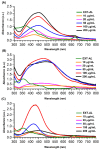Phytosynthesis and Characterization of Silver Nanoparticles from Antigonon leptopus: Assessment of Antibacterial and Cytotoxic Properties
- PMID: 40430963
- PMCID: PMC12115336
- DOI: 10.3390/pharmaceutics17050672
Phytosynthesis and Characterization of Silver Nanoparticles from Antigonon leptopus: Assessment of Antibacterial and Cytotoxic Properties
Abstract
Background: Silver nanoparticles (AgNPs) show promises as antimicrobial biomaterials with use for combating multidrug-resistant microorganisms, and they are widely used in healthcare, medicine, and food industries. However, traditional physicochemical synthesis methods often require harsh conditions and toxic reagents, generating harmful waste. The synthesis of AgNPs using plant-derived bioactive compounds offers an eco-friendly alternative to conventional methods. Methods: In this study, a bio-green approach was employed to synthesize AgNPs using ethanolic extracts from Antigonon leptopus leaves (EXT-AL). The synthesis was optimized under different pH conditions (5.5, 8.0, 10.0) and EXT-AL concentrations (10-200 μg/mL). Antibacterial activity was evaluated against Escherichia coli and Staphylococcus aureus, and cytotoxicity was assessed in HeLa, CaCo-2, T731-GFP, and HaCaT cell lines. Results: UV-Vis spectroscopy confirmed nanoparticle formation, with a surface plasmon resonance peak at 410 nm. Alkaline conditions (pH 10.0) favored the formation of smaller, spherical AgNPs. Characterization by DLS, TEM, and AFM revealed uniform nanoparticles with a hydrodynamic diameter of 93.48 ± 1.88 nm and a zeta potential of -37.80 ± 1.28 mV. The AgNPs remained stable in Milli-Q water but tended to aggregate in PBS, DMEM, and MHB media. Antibacterial assays demonstrated significant bactericidal activity against Escherichia coli and Staphylococcus aureus at 3.9 μg/mL (Ag⁺ equivalent). Cytotoxicity tests showed no toxicity to HeLa, T731-GFP, CaCo-2, or HaCaT cells at concentrations ≥ 7.8 μg/mL after 24 h. Conclusions: These findings highlight Antigonon leptopus extract as a sustainable and cost-effective resource for AgNPs synthesis, with strong antimicrobial properties and potential biomedical applications.
Keywords: Antigonon leptopus; antibacterial activity; cytotoxic properties; phytosynthesis; silver nanoparticles.
Conflict of interest statement
The authors declare no conflict of interest.
Figures










Similar articles
-
Phytosynthesis of Silver Nanoparticles Using Perilla frutescens Leaf Extract: Characterization and Evaluation of Antibacterial, Antioxidant, and Anticancer Activities.Int J Nanomedicine. 2021 Jan 6;16:15-29. doi: 10.2147/IJN.S265003. eCollection 2021. Int J Nanomedicine. 2021. PMID: 33447027 Free PMC article.
-
Biogenic Synthesis of Silver Nanoparticles using Lasiosiphon eriocephalus (Decne): In vitro Assessment of their Antioxidant, Antimicrobial and Cytotoxic Activities.Pharm Nanotechnol. 2023;11(2):180-193. doi: 10.2174/2211738511666221207153116. Pharm Nanotechnol. 2023. PMID: 36503464
-
Optimization of Silver Nanoparticle Synthesis by Banana Peel Extract Using Statistical Experimental Design, and Testing of their Antibacterial and Antioxidant Properties.Curr Pharm Biotechnol. 2019;20(10):858-873. doi: 10.2174/1389201020666181210113654. Curr Pharm Biotechnol. 2019. PMID: 30526454
-
The effect of coffee as a bio reductant in the synthesis of silver nano particles combined with laser photodynamics for bacteria inactivation.Braz J Biol. 2025 May 2;85:e288042. doi: 10.1590/1519-6984.288042. eCollection 2025. Braz J Biol. 2025. PMID: 40332206
-
Sustainable phyto-fabrication of silver nanoparticles using Gmelina arborea exhibit antimicrobial and biofilm inhibition activity.Sci Rep. 2022 Jan 7;12(1):156. doi: 10.1038/s41598-021-04025-w. Sci Rep. 2022. PMID: 34997051 Free PMC article.
Cited by
-
Recent Trends in Bioinspired Metal Nanoparticles for Targeting Drug-Resistant Biofilms.Pharmaceuticals (Basel). 2025 Jul 5;18(7):1006. doi: 10.3390/ph18071006. Pharmaceuticals (Basel). 2025. PMID: 40732295 Free PMC article. Review.
References
-
- Owen R., Crane M., Grieger K., Handy R., Linkov I., Depledge M. Nanomaterials: Risks and Benefits. Springer; Berlin/Heidelberg, Germany: 2009. Strategic Approaches for the Management of Environmental Risk Uncertainties Posed by Nanomaterials.
-
- Ahire S.A., Bachhav A.A., Pawar T.B., Jagdale B.S., Patil A.V., Koli P.B. The Augmentation of nanotechnology era: A concise review on fundamental concepts of nanotechnology and applications in material science and technology. Results Chem. 2022;4:100633. doi: 10.1016/j.rechem.2022.100633. - DOI
-
- Haleem A., Javaid M., Singh R.P., Rab S., Suman R. Applications of nanotechnology in medical field: A brief review. Glob. Heal. J. 2023;7:70–77. doi: 10.1016/j.glohj.2023.02.008. - DOI
-
- Mohammed N., Nawar S., Etawy M., Nassar G., Hassabo A. Nanotechnology and its Applications in Industry and Product Design. J. Text. Color. Polym. Sci. 2024;21:273–284. doi: 10.21608/jtcps.2024.258215.1251. - DOI
-
- Sahoo M., Panigrahi C., Vishwakarma S., Kumar J. A Review on Nanotechnology: Applications in Food Industry, Future Opportunities, Challenges and Potential Risks. J. Nanotechnol. Nanomater. 2022;3:28–33. doi: 10.33696/nanotechnol.3.029. - DOI
LinkOut - more resources
Full Text Sources
Miscellaneous

